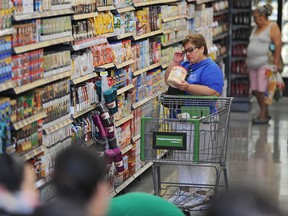Figuring out if a product is Canadian isn’t always easy. Here’s how to tell the difference between ‘Product of Canada’ and ‘Made in Canada’

There’s an issue, though: Figuring out if a product is Canadian isn’t as straightforward as you might expect. “Product of Canada” isn’t the same as “Made in Canada,” though both apply to foods at all levels of trade — whether bulk, wholesale or retail — restaurants and advertising.
‘Product of Canada’ or ‘Canadian’
According to the CFIA, companies voluntarily make “Product of Canada” and “Made in Canada” claims. Once they’ve made them, they must adhere to the guidelines.
“Product of Canada” applies when a food product’s primary ingredients, processing and associated labour are Canadian. The minor use of ingredients not typically grown or produced in Canada, such as spices, oranges, sugar and coffee, wouldn’t disqualify a food from bearing the label.
‘Made in Canada’
As with “Product of Canada,” companies can label products “Made in Canada” if the last significant step in processing happens here — even if some ingredients are foreign. According to the Competition Bureau, non-food products must contain at least 51 per cent Canadian content.
Companies are required to include a qualifying statement with “Made in Canada” claims. For example, a cookie made in Canada using imported flour, oatmeal, sugar and shortening could bear the label “Made in Canada from imported ingredients.”
Let’s say that same cookie was made with flour milled from Saskatchewan grain, Manitoba oats, Quebec butter and imported sugar. The producer could label it “Made in Canada from domestic and imported ingredients.”
‘Prepared in Canada’ and other domestic content claims
Swapping American products for Canadian ones is more difficult for some categories than others.
“Dairy, beef, chicken, pork — Canada produces plenty of these, and supply management keeps them local. Root vegetables like potatoes, carrots and beets are easy to find from Canadian farms, and grains like wheat, oats and lentils are a huge part of our agriculture,” said Charlebois.
“Anything tropical — bananas, oranges, lemons, avocados, pineapples — those all come from way further south. A lot of packaged snacks and processed foods are also tough because so many of them are made in the U.S. or rely on American ingredients, products ‘Prepared in Canada.’”
The CFIA encourages companies to use “Product of Canada” and “Made in Canada” (with a qualifying statement) to help consumers identify domestic content. However, a raft of other claims are also allowed, including “Prepared in Canada,” provided they’re “truthful and not misleading.”
Examples include coffee beans (which are always imported) labelled “Roasted and blended in Canada,” imported cane sugar that was “Refined in Canada” and food imported in bulk that was “Packaged in Canada.”
Our website is the place for the latest breaking news, exclusive scoops, longreads and provocative commentary. Please bookmark nationalpost.com and sign up for our daily newsletter, Posted, here.